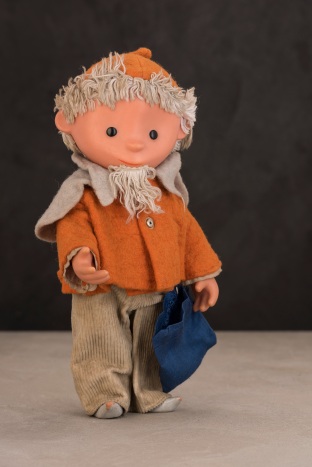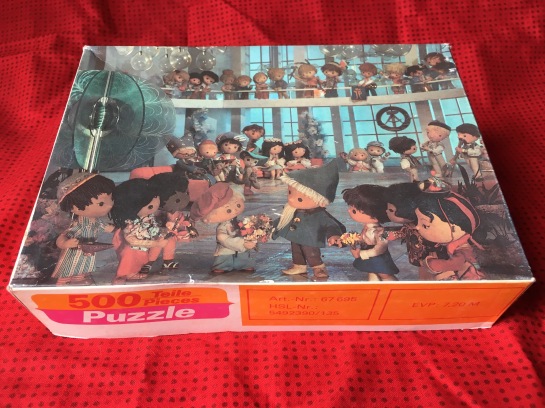Sweet Dreams Are Made of This: The Sandman

Sandman doll with his bag of sand, 25 cm (photo: J. Zarth).
Surveying the landscape of post-unification German culture, it is hard to find many examples of cultural products from the GDR-era which still have a place in the new Germany.
In fact, I can only come up with two: the Sandmännchen, the subject of today’s post, and the Ampelmännchen, the distinctively East German pedestrian crossing lights. (ed. note: I find it rather remarkable that Ampelmännchen survived given that its design was inspired by a photo of the GDR’s Panama hat loving leader Erich Honecker. Considering the thoroughness with which remnants of the SED dictatorship were erased from the eastern German public space in the 1990s, how this escaped attention baffles me still today. But I digress . . .)
A Brief History of the Sandman
The Sandman is the star of a night-time TV series for small children which was the brainchild of one Dr. Ilse Obrig, an academically-trained children’s broadcaster who began her career with the Nazi’s Reichssender Berlin radio station in 1936, a position she retained throughout the war years. Dr. Obrig spent the first years after the war helping establish Berliner Rundfunk in the city’s Soviet zone of occupation, and was working to develop the Sandman program for Berliner Rundfunk’s children’s programming when she left East Berlin for the western side in 1950. There she took a position with Radio In the American Sector (RIAS), the western broadcaster perhaps most openly despised by Party apparatchiks in the East. In her absence, Berliner Rundfunk developed the Sandman idea and brought it to air in 1956
In late 1959, word trickled back to East Berlin that Obrig was developing a Sandman TV series for the West Berlin station Sender Freies Berlin (SFB/Free Berlin Broadcaster) and GDR authorities quickly decided that this affront could not go unchallenged. They swung into action to produce Unser Sandmännchen (Our Sandman), a stop-motion animated children’s TV show which would first air in November 1959, one month before Obrig’s Sandmanns Gruss für Kinder (Sandman’s Greetings for Children) arrived on West Berlin screens.
Our Sandman
Tasked with bringing Our Sandman to the small screen as quickly as possible fell to Gerhard Behrendt, a puppet master and writer, and he didn’t disappoint. Behrendt created the iconic Sandman doll in just two weeks and would go on to oversee production of the show for more than 35 years, right through to the end of the GDR. Produced in a short film format and broadcast every evening at 6:50 pm, Our Sandman followed the title character through his activities, some adventurous, others decidedly less so. The program’s warm and innocent tone quickly made it a favourite with East German children and parents alike, with many preferring it to the West German version that launched a week after Our Sandman.
And the Sandman proved to be popular not only with East Germans, but was a rare cultural export success for the GDR. Indeed, sales of the show to many countries including Denmark, Greece and Switzerland brought in highly-desired hard currency to East Germany.

The “father” of the GDR Sandman, Gerhard Behrendt (r.) with several of his team members in November 1979 on the 20th anniversary of the first Sandman TV show (Photo: bundesarchiv_bild_183-u1109-023_berlin_sandmc3a4nnchen.jpg).
My friend Falko W. is a member of the GDR’s last generation and has fond memories of the Sandman. Born in 1984, he tells me, “watching that show was really normal activity and I definitely grew up that way.” Julia G., was a bit older (born in 1978), but has similar memories: “It was part of our daily routine. We found it to be beautiful and imaginative, much more so than the West Sandman. He was just not that interesting visually. We watched it too, but it didn’t have the same charm.”
Politics for Pre-Schoolers?
There can be no doubt though that Our Sandman was instrumentalized politically on some occasions. As a writer in Germany’s Die Welt newspaper put it on the 50th anniversary of the program in 2009, “There’s no question that Sandman was a member of the Party. He just never showed his little red membership book.” (“Das Sandmännchen wird 50 Jahre alt”, Die Welt, Nov. 22, 2009, by Claudia Becker). Over the years the show included episodes where Sandman visited the National People’s Army, GDR Border Troops, the Oder/Neisse “Freedom Border” with Poland and Party-run summer camps. My collection includes a puzzle with a scene taken from an episode where Sandman visited the Palace of the Republic, the East German parliament and perhaps “the” symbol of Party rule in late-stage GDR (see below).

Sandman visits the Palace of the Republic (Annaberger Puzzle)
I asked both Falko and Julia whether they recall any episodes of Our Sandman with clear ideological content, and both say they don’t. “As kids,” offers Julia, “we didn’t watch in a critical way. and our parents weren’t critical [of the regime]. . . . I spoke with my father about this just now, and he said that there wasn’t anything political in the show, but I have some vague recollections of this. Thanks to the fact that our parents never really discussed politics with us, we didn’t really have any sort of consciousness for that sort of thing.” She smiles ironically: “I guess I was just one of those blissfully unaware GDR children who didn’t have to worry about anything!”
Falko doesn’t recall experiencing the show as being openly ideological either, but notes that, later in life it occurred to him that “Sandman really liked to visit his ‘brothers and sisters’ in the Soviet Union,” visits that often depicted life there as a rural paradise with the characters dressed in their traditional national folk outfits. There is something markedly anachronistic about this depiction of the Soviet people’s, particularly in the context of the GDR in the 70s and 80s, in that it echoes an image of Soviet Union that had not been prevalent since the Stalin era.
It’s important to note, however, that the image of the Soviet Union on Our Sandman was not monolithic. In addition to being shown as a rural idyll, the country was also presented as the leading technological power, a theme typically taken up in what Falko tells me were his favourite episodes: the ones which took Sandman to space. While there, it was not unusual for him to encounter other space explorers from the Soviet Bloc. An example of this can be seen in the excerpt from the program’s credits, likely from the 1970s, seen below. Here Sandman travels to a Socialist Space Station (not the Red Star with Lenin logo on its outside) and meets up there with Cosmonauts from the Soviet Union, Poland and Czechoslovakia.

Scene from episode of Our Sandman which was banned shortly before its initial broadcast after two East German families used a hot air balloon to flee the country (Photo: bundesarchiv_bild_183-1984-1126-312_sandmc3a4nnchen_25-_geburtstag.jpg).
Typically, however, the program seems to have tried to steer clear of openly ideological agitation. Instead, episodes were divided into those meant to spur viewers’ imaginations (e.g. Fairy tale adaptations, space exploration) and others which reflected the world that East German children saw around them (for example, by using sets featuring the GDR-typical Plattenbauten (pre-fab buildings). Sometimes, Sandman would run afoul of authorities by coincidence; one anecdote has it that an episode featuring a hot air balloon was banned shortly before going to air after two East German families escaped to the West using this method of transportation.


Good one!
Mark Webber (mobile)
>
Thanks for sharing this very well written, informative piece. Much, of course as it should be, is written about Vopos and Stasis and the wall (I am just finishing Frederick Taylor’s excellent “The Berlin Wall”), and the tremendous pain they caused. Not so much is written about less glamorously evil, and (if one can believe!!) innocent or even happy elements of GDR life, which this apparently was. It takes both for a complete picture so thanks for this !!!
Thanks for reading and the kind words!
Hello!
Kids in Finland from the 70s all the way to the noughties grew up watching Sandmännchen (Nukkumatti in Finnish). He was even in Finland in two episodes written by Taina Repo. Never considered any political overtones (or undertones…?) when I watched it in the 80s. A true classic among Finnish kids!
Thanks for a great blog, I’ve enjoyed reading it for a while now.
Cheers,
Saku
Hi,
Thanks for this information. The Sandman seems to have traveled quite well. Interesting that they had him visiting Finland later on, but given the popularity there, I suppose that makes sense.
I would imagine that foreign broadcasters simply opted not to air those GDR-era episodes featuring overt propaganda, such as visits to National People’s Army garrisons and such. If that was the practice, then I think most observers would’ve had a hard time identifying Sandman’s home country based on the show’s contents as, based on what I’ve seen, much of it was fairly standard children’s tv stuff.
Thanks for reading and taking the time to share your experiences.
Regards,
John Paul
Hi John Paul,
Tried looking around a bit if any of the heavier political propaganda stuff was not shown here, but couldn’t find any evidence in any which way.
The episode with Nukkumatti flying to space with a Soviet flag on the space ship was shown here definitely. Official Finland leaned heavily in a way towards the east (long border with Soviet Union and all that) during that time and censoring some episodes could’ve been politically hazardous. I wouldn’t deem it impossible that the episodes with visits to garrisons were shown here like any other episodes.
Maybe you’re aware of this, but there’s even a term for the behaviour official Finland practiced during the Cold War: https://en.wikipedia.org/wiki/Finlandization
Thanks,
Saku
Hi Saku,
Very interesting. You might be right about the broadcasting of the overtly political episodes; it might have been possible, but I would be surprised.
I know that Finland tried to walk a careful line during the Cold War, but I’d have thought that a kids show dedicated to a visit to, for example, the East German border might have been a bit beyond what was acceptable. That said, the show might have kept things ambiguous in a way that international broadcasters could use. I would love to get to see these contentious episodes but haven’t had the chance yet!
Appreciate your contributions!
Regards,
John Paul
Pingback: From rampaging teenagers to female assassins: why has East German culture become so cool? | Culture - Web Today
Pingback: From Rampaging Teenagers To Female Assassins: Why Has East German Culture Become So Cool? | Culture - USA NEWS NOW | Home Page
Pingback: From rampaging teens to female assassins: why has East German culture become so cool? | Culture - PioneerNewz